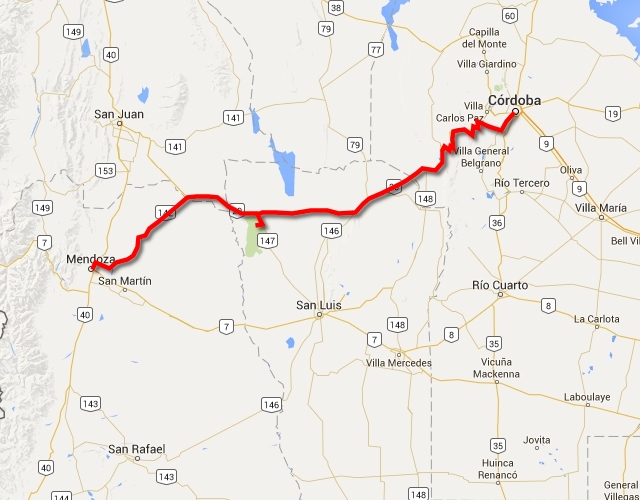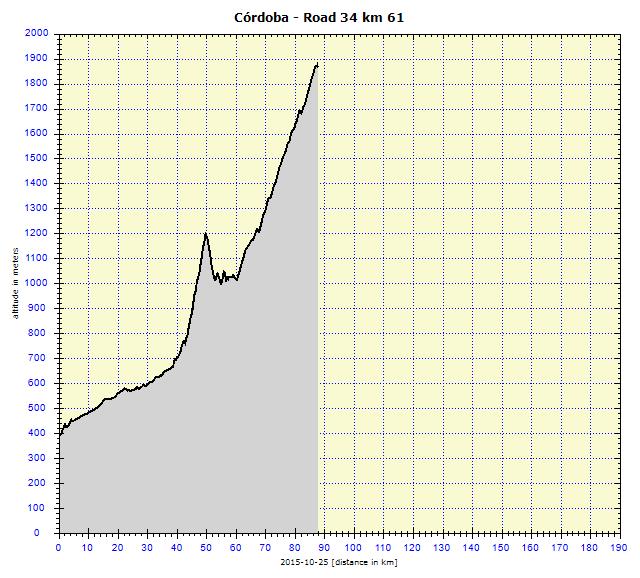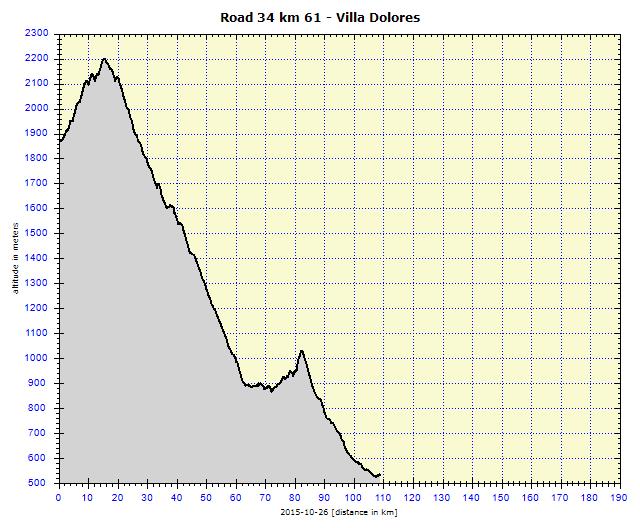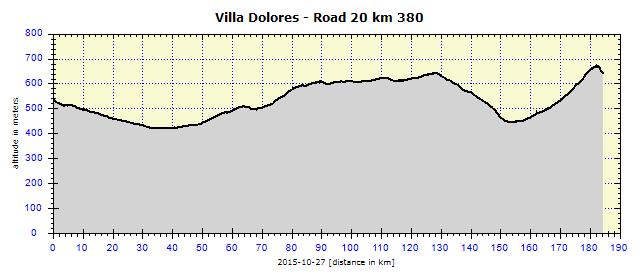
Nothing compares to the simple pleasure of a bike ride. J.F.Kennedy
Search this website
To Mendoza
Córdoba, F. del Carmen, El Cóndor, Mina Clavero, Nono, Villa Dolores, Quines, Luján, La Chaòarienta, Hualtaran, PN Sierra de las Quijadas, Hualtaran, Chaòarienta, La Tranca, Encón, Posta San Gabriel, La Asunción, Gustavo André, Lavalle, Las Heras, Mendoza
Wall to Wall
People living in the flat pampas region warned me that the area around Córdoba is very hilly. I tapped my legs and told them that they would manage it. I thought that locals in flatlands viewed every little hill as huge. I was already bored with cycling through the flat countryside, which was also the reason I picked the shortest route to Mendoza, which (even on a less detailed map) appeared to have some crazy bends. There was no river in the valley which the road could follow in such a style. It was obvious that it led over the hills. It would be fun, I thought. Loyal to my travel rule that it was better to be surprised, I did not research how high the hills were. Quite high, I admitted, after I had pedaled up to 2 200 meters above sea level.
The following morning, I made scrambled eggs with onion and then even ate up the standard hostel breakfast. I spread some bread for the afternoon snack, not knowing that it was also to be my dinner and breakfast on the following day. I passed through Córdoba like a knife through butter in the quiet Sunday traffic. On the outskirts, I was stopped by a man waiting for a bus next to the road. He was also a long-distance cyclist. He had been on two trips – from Córdoba to Cusco in Peru and the second one from Bolivian La Paz to Ushuaia (I knew that route from my own experience). He invited me home for a few days or at least for breakfast or lunch. I thanked him, but refused his hospitality.
I entrusted the navigation to the GPS, which was very busy. First I cycled on the standard highway, where cycling was not forbidden. The second time in Argentina I had seen at a highway tollgate that even motorcyclists paid a fee. From the highway it took me to another extreme, I was navigated to a 12-km long unpaved road with a reasonably good surface. A pleasant change after the highway. The dirt road took me to the correct road which began a consistent ascent. Some parts were very steep, often with bends, so I had to work hard to make it even in the lowest gear. I was wiping the sweat from my forehead, yet at the same time I was happy to experience the change from the never-ending flatland with a headwind. After 15 km, I arrived at an observatory, the road started descending and I thought it was over.
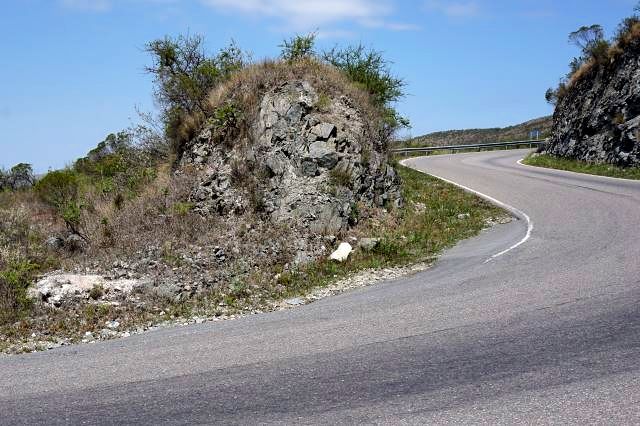
Road from F. del Carmen: Very steep ascending road, especially on the bends
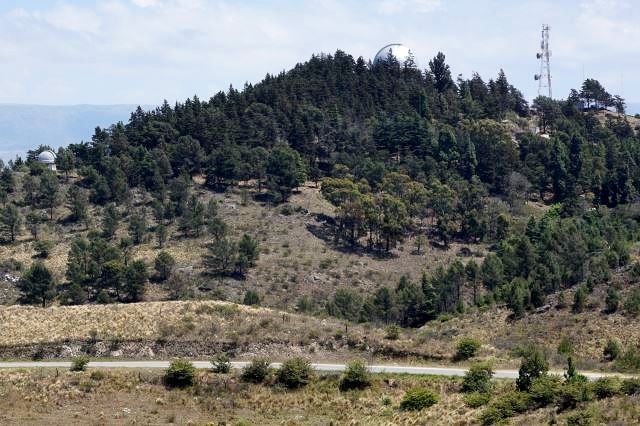
Road from F. del Carmen: Observatory and first descent
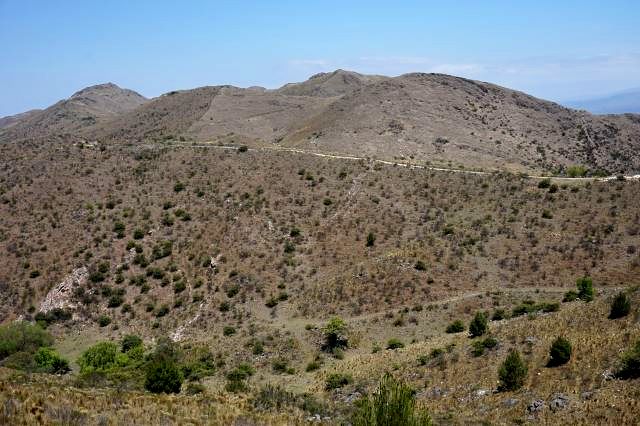
Road from F. del Carmen: Road near observatory
However, the descent was short. A twisting road took me to Road 34. At first, it seemed as if the route was flat, but I had no energy. Initially I thought it was due to the snack which I had eaten and which my body needed to digest. Then I checked the wheels to see if there was anything slowing them down and, at that moment, I noticed the strong headwind and my clinometer on my cyclocomputer displayed a significant ascent. This situation persisted right through to the evening. The observatory was still in sight as the road continued on the other side of the valley. With the zigzagging type of road I was gaining altitude. Luckily there were no extremely steep parts.
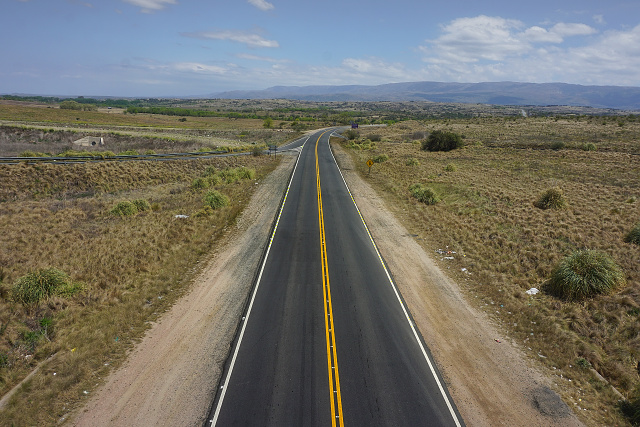
Begining of road 34: In the distance are mountains through which the road leads
My water supply was running low. No river in sight and no water coming from any rocks around. I only spotted water in one ravine, but could only have reached that with mountaineering equipment. Finally I succeeded, when coming across a guard guarding building machinery and who had a 20-liter demijon full of water outside his caravan. One hour later, I had drunk up all the water he had given me and ended up with the same problem. I arrived at the first possible place to get supplies – a parador. I drank up all the remaining water and entered the restaurant. I did not get very far, the place was closed. There was no other option. I inspected the vicinity, disconnected a hosepipe used for watering the grass, filled my bottle and then returned everything to its original state. The water was evidently not drinkable so I treated it with a SteriPen.
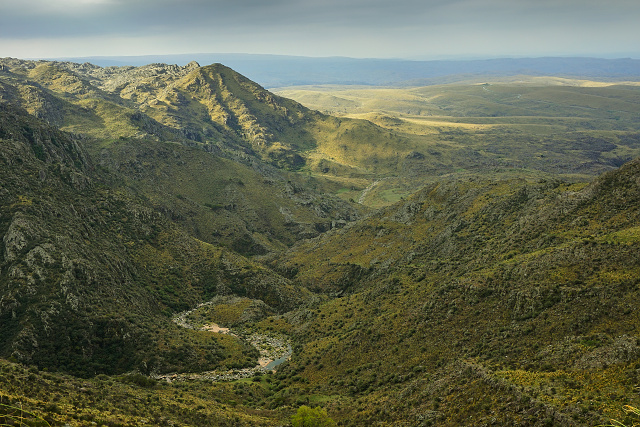
Road 34: Surrounding countryside
At 1700 meters, I was attacked by the cold. People were wearing quilted jackets and I was in shorts and a worn-out cycle outfit. I did not need other clothes, I warmed myself up on the next hill. 10 km later, I came across another restaurant. Choosing from their very limited menu, I picked three expensive empanadas (13 pesos each), which was to be my only meal of the day. I was surprised by the barman, who needed to use a calculator to calculate 3 x 13. He had probably studied Tourism or some other ‘soft’ science, which has become so popular in Europe lately.
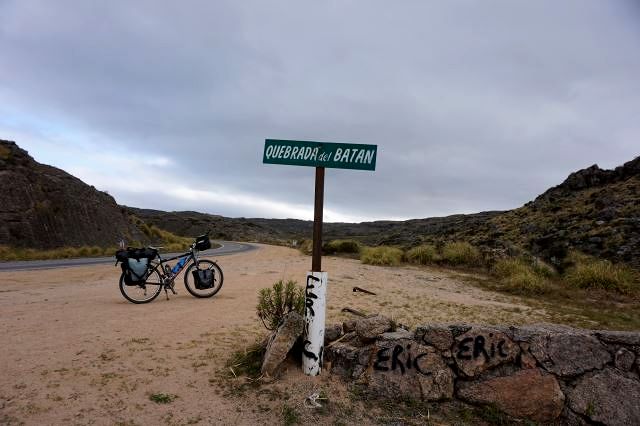
Road 34: Quebrada de Batan
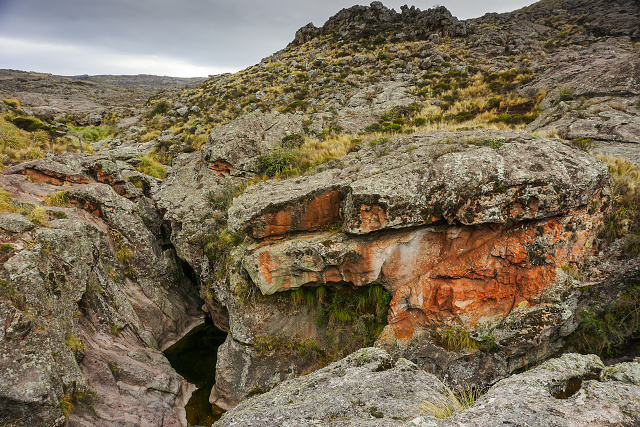
Road 34: Quebrada de Batan
It was getting late, the road was still ascending and I had to find a place to sleep. It was not a problem. After 20 minutes, I located a grassy spot on otherwise stony flat ground, separated from the road by a rock. When pitching my tent, I felt freezing cold. The liquor would have been useful at that moment. Regardless of the cold, I undressed. Instead of washing, I wiped myself with baby-wipes and withdrew into the tent. I bundled myself up in the sleeping bag, planning to warm up a little and then to work on my laptop and also read something. I woke up 11 hours later at 07:00.
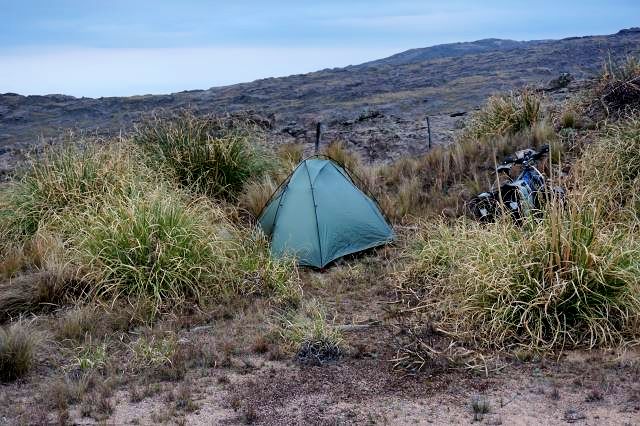
Road 34: In the evening, I camped behind a rock near the road…
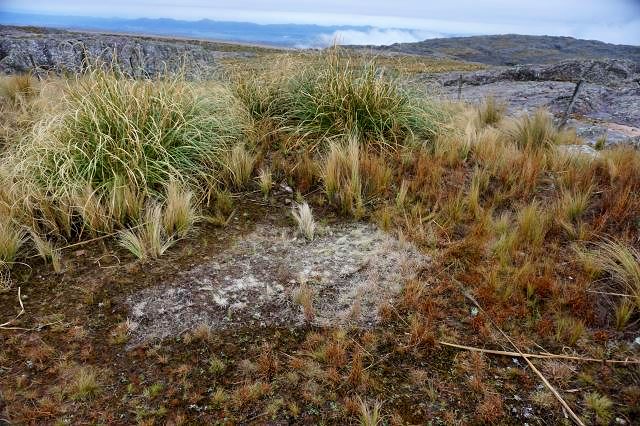
Road 34: ... and in the morning, after I left, only a dry spot remained
The night’s rain had ceased by the morning, which made it possible for me to boil Mate from the water I had fortunately taken from the restaurant the day before. With that, I ate the rest of the bread with cheese and ham. I was fascinated by the human body's ability to adjust to the given conditions. The previous day there had been a high output and a low input (of food). The body had used up all the food, every little bit, so I could skip one of the regular morning acts.

Road 34: La Pampilla - all shrouded in clouds
The road continued to climb even higher. I checked the altitude on my GPS, I was over 2000 meters above sea level. I was in the clouds, it was raining heavily, I had to put on my rainproof clothes. The visibility was only a few feet ahead of me, so I turned on the red blinking light. 10 km later, I reached the El Cóndor restaurant and surprisingly it was open. I was their only (and possibly first) guest, but the meal choice was good. I ordered a hot sandwich, Creole empanada and coffee. I was very content, thinking that the world was so convivial even 2200 meters above sea level.
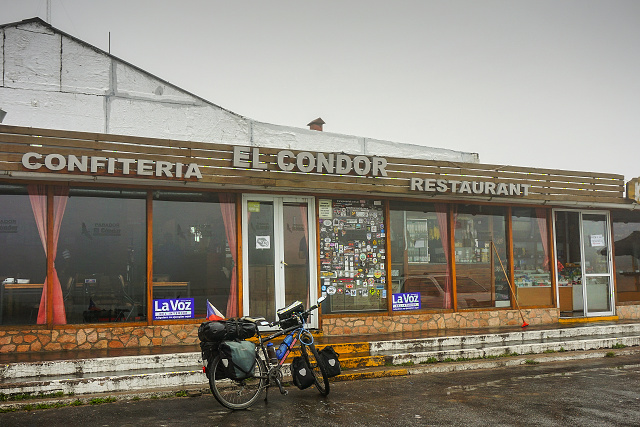
Road 34: El Cóndor - fortunately it was open
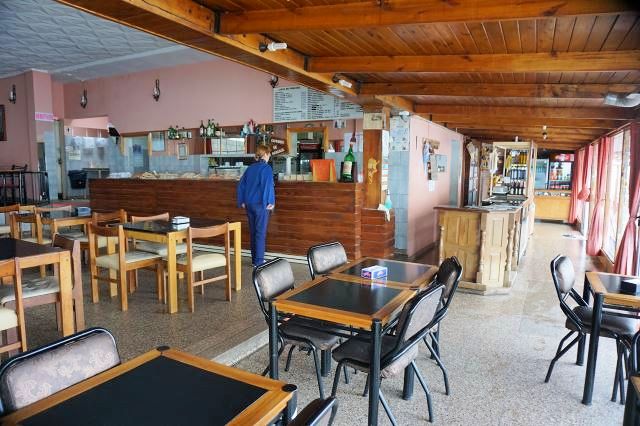
Road 34: El Cóndor - restaurant almost on top of the hill
Prices were markedly lower than at the previous restaurant, even though the location was several hundred meters higher, so they could have applied an additional mountain charge. They might have been charging extra for other services. There were several good-looking girls employed. Feeling joyful, I checked the altitude chart on the GPS and found that I would reach the summit after about 5 km and then the road would start descending.
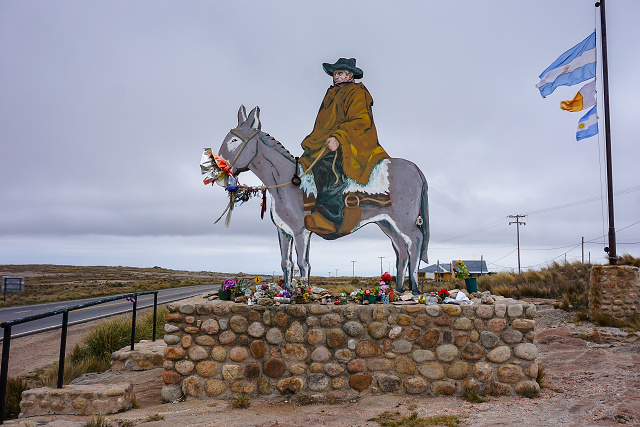
Road 34: La Posta - statue of popular Padre Brochero
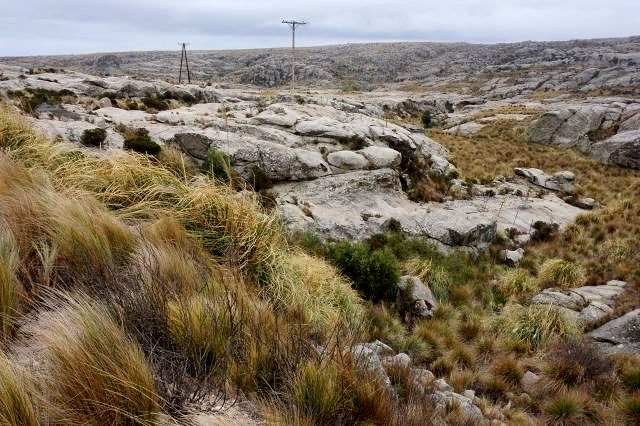
Road 34: La Posta - landscape in Parque Nacional Quebrada del Condorito
The GPS was not lying. I first pedaled through the upland pampas, La Pampilla, then the road descended three times and ascended three times, until it definitely changed downhill and, several kilometers later, I exited the clouds and started to admire the rough, scenic rocky landscape of the Quebrada del Condorito National Park. I saw many Condors, some even at a distance of 5 meters. They were smart fellas! Before I could take out my camera, they always flew away.
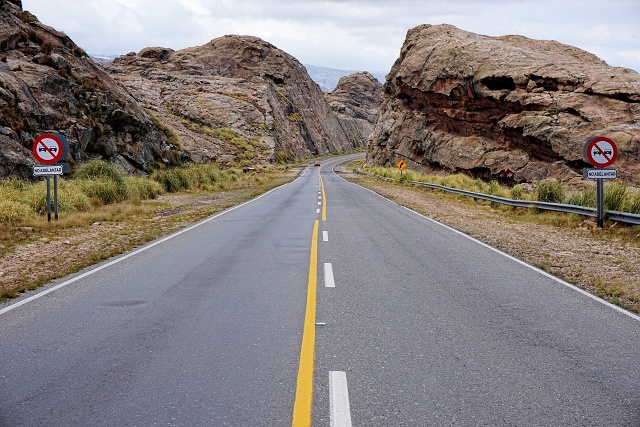
Road 34: The road winds impressively among the rocks
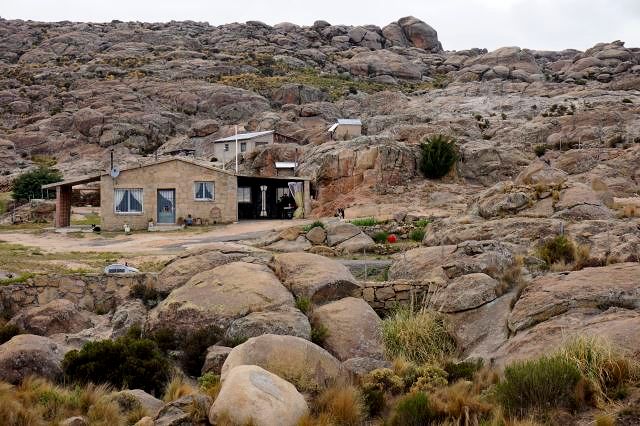
Road 34: Stones and rocks do not give much chance of a decent livelihood
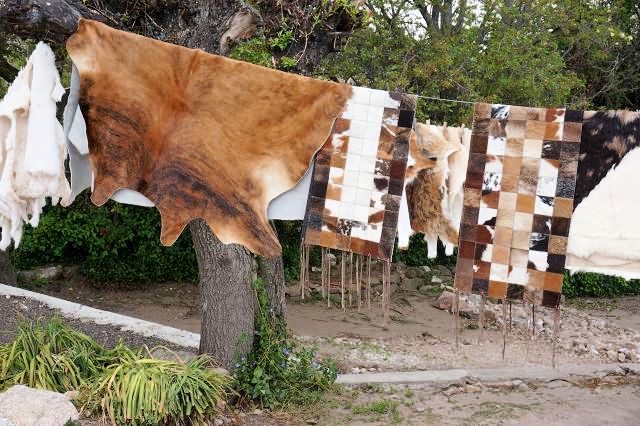
Road 34: Skins for sale at the roadside
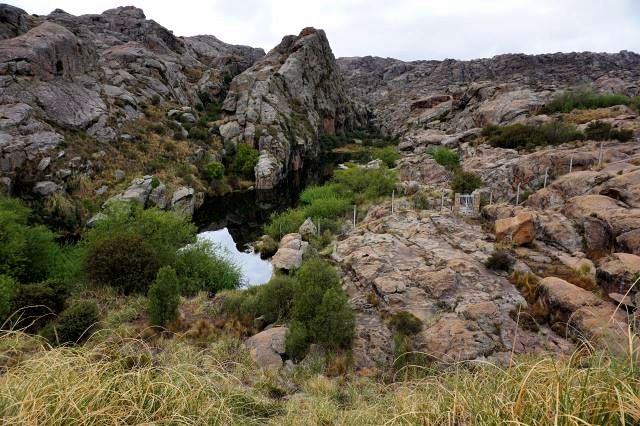
Road 34: Water is scarce here
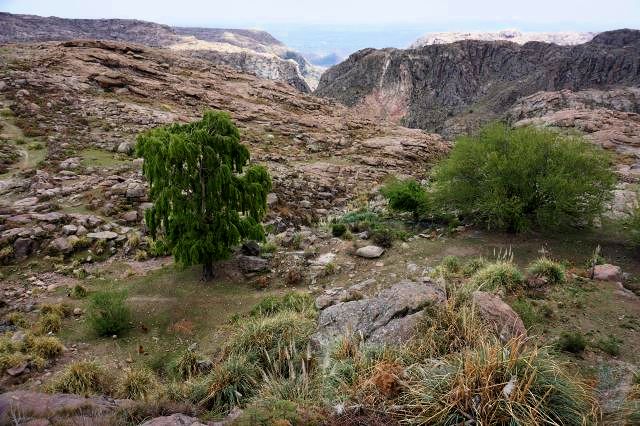
Road 34: Surroundings
I was cycling as fast as 45 to 57 kph. Of course I had to brake, so I would not fly off on one of those truly sharp tight bends (curva cerrada). Most importantly, I admired the countryside, stopping ever so often to photograph it. The downhill ended after 45 km, before Mina Clavero, where the spring weather was so amazing that I removed my leg warmers and took off my jacket. Then I even cycled about 10 km uphill, followed by 28 km downhill to Villa Dolores. I can highly recommend crossing the Sierras de Córdobas — it left a truly deep impression on me.
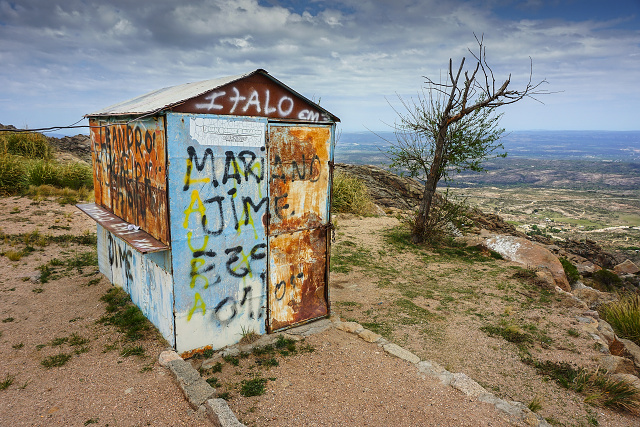
Road 34: A store selling local products is not really prospering
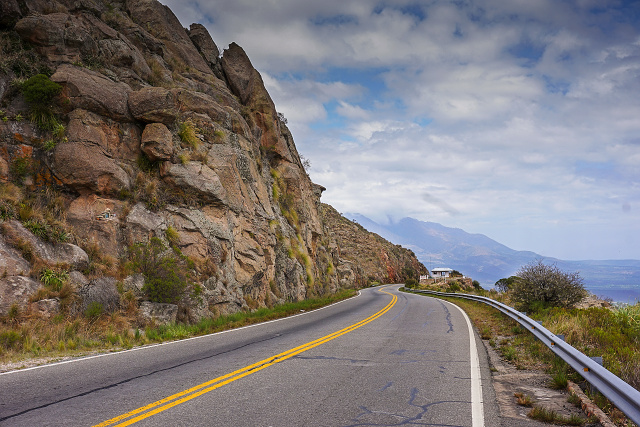
Road 34: Highway 34
At 08:30 in the morning, I went into a total windless day, again across the boring pampas on Road 20, which at least provided a quality surface. Due to little traffic, it did not matter that it lacked a verge. I stopped at an Info Center in Quines, wanting to ask about the possibilities of buying food on the next 100 km of Road 20. The lady in the office had such a cold that, directly after exchanging greetings, we parted ways and I quickly left the office. I was truly not that keen to get ill.
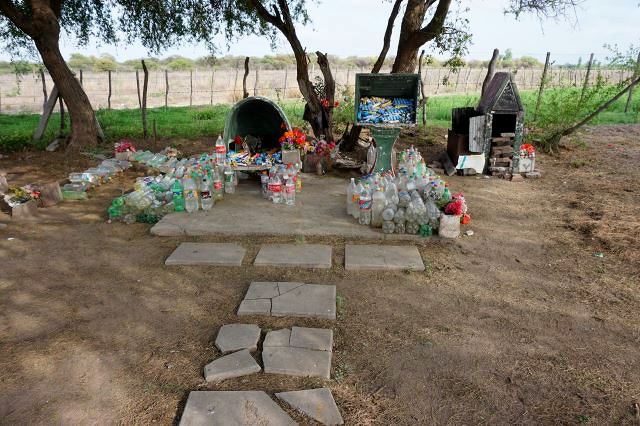
Road 20 near Villa Dolores: Gauchito Gill surrounded by love and plastic bottles
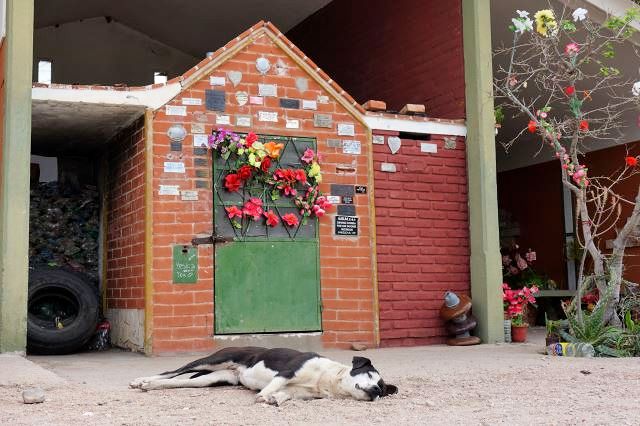
Road 20 near Quines: A dog guarding Gauchito’s shrine
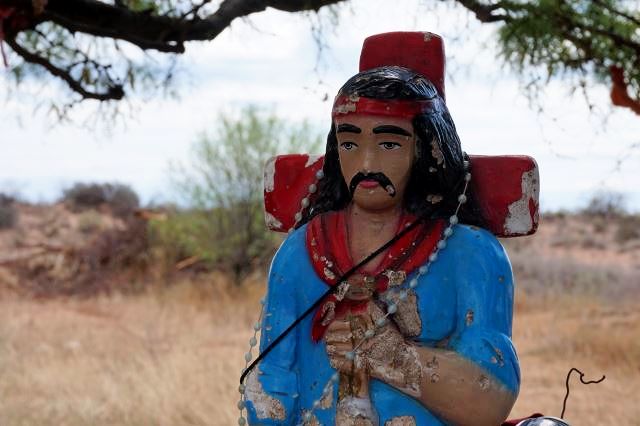
Cruz de San Pedro: Gauchito Gill with his typical innocent glance
In Luján, the busy Road 146 to San Luis split from Road 20. Initially I wanted to replenish my supplies there, but I was lazy to cycle that one kilometer into the center. The map displayed several circles on Road 20, meaning that there were villages, so I thought I would have the opportunity to shop later, so that the food would not spoil in the heat. I was wrong. There was absolutely nothing for the next 120 km.
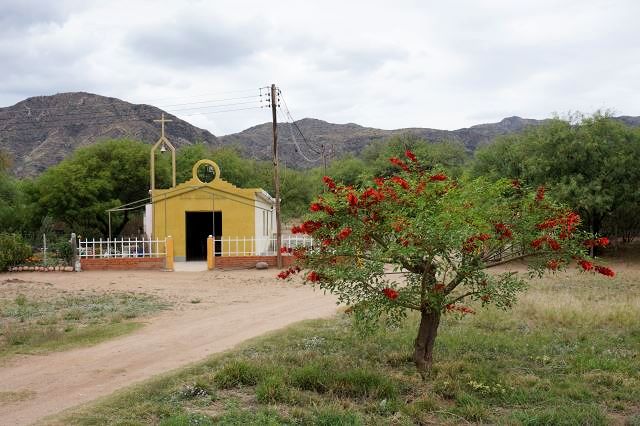
Road 20 near Quines: Church beneath the mountains
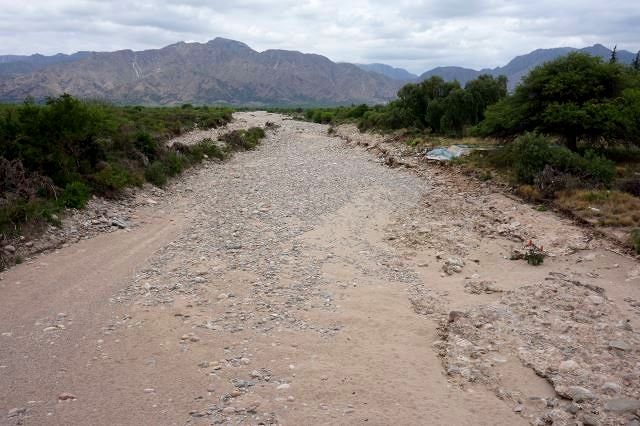
Road 20 Río Luján: Water is scarce in this region, not a drop in the wide riverbed
I had an acute shortage of drinking water. I crossed several rivers, all were dry. Although estancias could be reached via the road exits, the houses were several km away. Not a soul anywhere. Minimal traffic – about five cars per hour. Finally, I saw a group of workers building a telecommunications spire. They had a tank full of water, allegedly drinkable from an artesian well from nearby willage. That saved me.
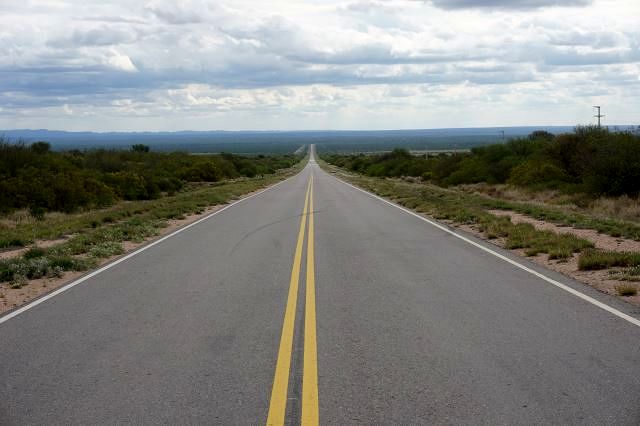
Road 20 near La Chaòarienta: Quality surface, little traffic
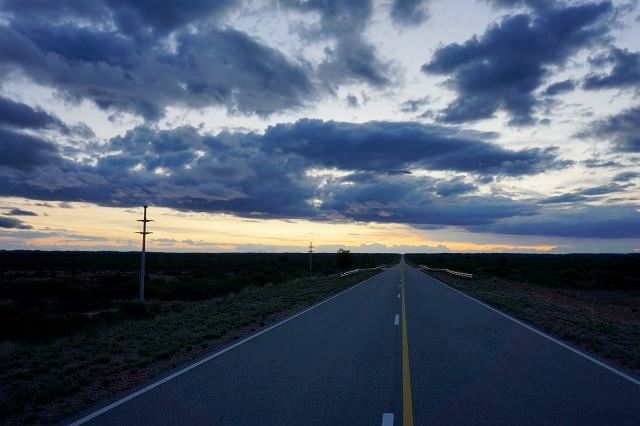
Road 20 near La Chaòarienta: After sunset
I knew that I could not make the 220 km to the National Park where I was heading. I cycled as long as possible and, one hour before sunset, started searching for a spot to sleep. It was not easy, even though there were 50-meter wide strips along the road, they were overgrown with cactuses and thorn bushes. Among these were areas of powdery sand, which would get into everything. Patience is a virtue. In the end, I found a grassy spot under a tree to which I could push my bicycle. Although it was visible from the road, it was getting dark and there was no traffic anyway. For dinner I ate my left-over snack and finished the rest of a bottle of red wine while watching the dramatic sunset and looking out for UFOs, as promised to the rocker in Pergamino. Instead of a UFO, an ugly cloud winked at me, so I went to sleep instead.
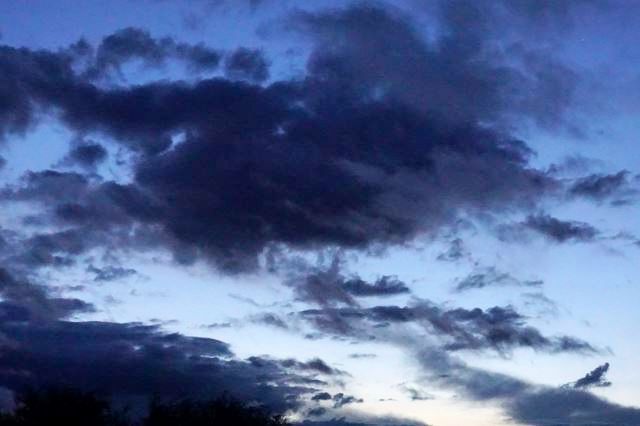
Road 20 near La Chaòarienta: Clouds glowered at me
I really got myself fit, tearing up the asphalt. During the Sunday mountain session, I burned an all-time record of calories — almost 4000! I had once again covered more than 180 km and, if I’d had more time, would have reached the magical number - 200 km! While the first 100 km were windless, for the remaining 80 km, I had a mild wind, more or less from behind. I would have to to pour several jugs of Malbec down my throat in Mendoza in order to slow down the excited body from its achievements.
My supplies were getting low. My breakfast consisted of one banana and a piece of sponge cake, locally known as budin. I expected to be able to eat at La Chanarienta, 9 km away, marked on the map with a big circle. There was only one building, but they informed me that at Hualtaran, 10 km further on, there was a store. Good news! I was already heading there, as the access road to the National Park starts there. I did find the store next to the road, but it was closed.
Parque Nacional Sierra de las Quijadas
An unknown and not much visited Park, even though it is prominent due to the beautiful eroded rocks, and deep canyons like in a Wild West cowboy movie. I paid the pricy entrance fee of 120 pesos, then purchased some biscuits for about the same price — the only product they sold. There was also a free campsite in the Park, with a water tank – although the water was undrinkable. The water was led to the bathrooms where it filled buckets for flushing the toilets. Nevertheless, there was water and I could easily spend a day in the Park. I purified the water with my SteriPen and also boiled some Mate. My emergency reserve consisted of spaghetti and a can of tuna as the only main meal. The following morning I would eat the biscuits which had to fuel me to Encón almost 100 km away.
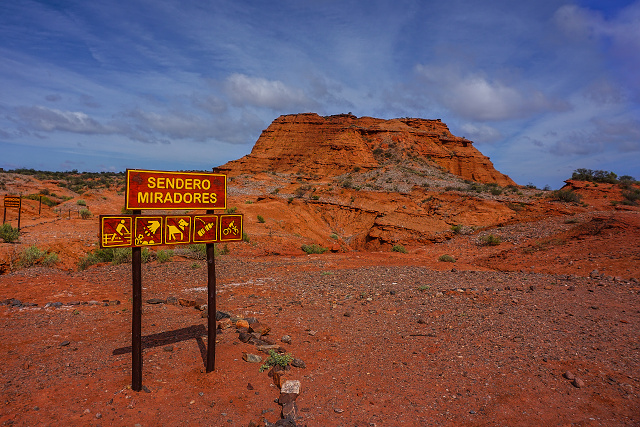
Parque Nacional Sierra de las Quijadas: Beginning of the scenic trail
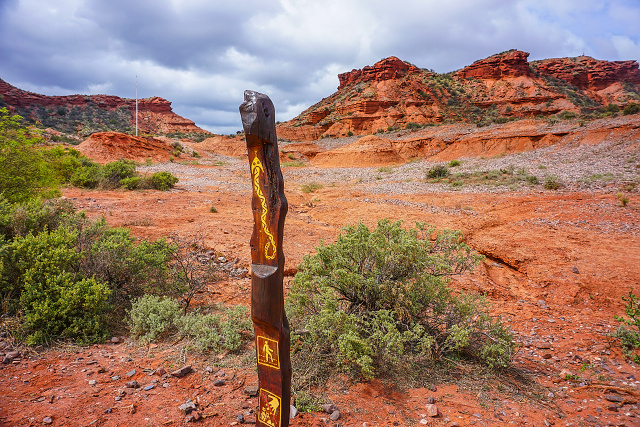
Parque Nacional Sierra de las Quijadas: The start of one of the trails
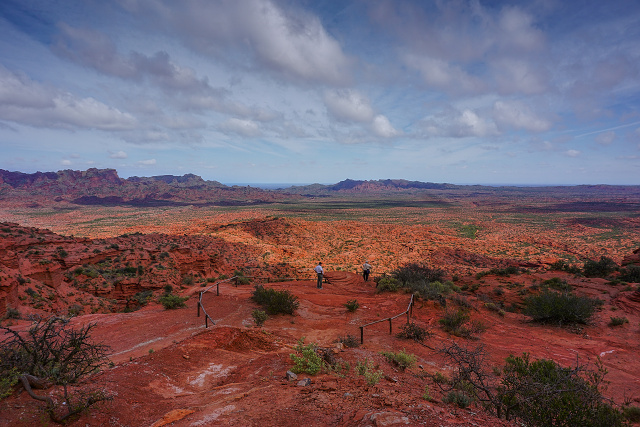
Parque Nacional Sierra de las Quijadas: South terrace
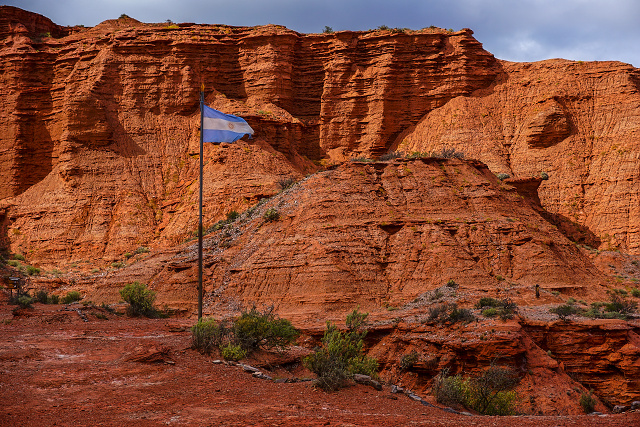
Parque Nacional Sierra de las Quijadas: Vertically ridged cliffs
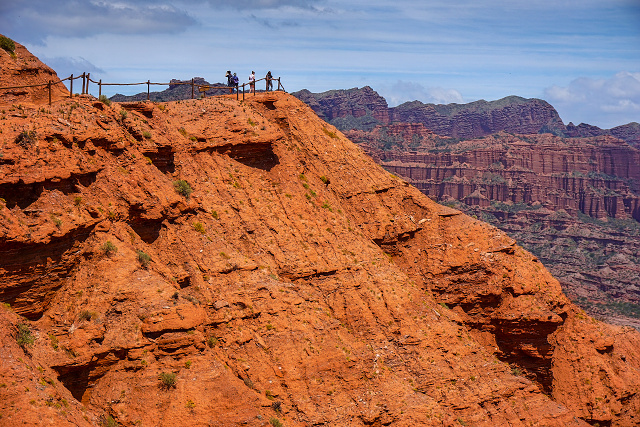
Parque Nacional Sierra de las Quijadas: Rock vista
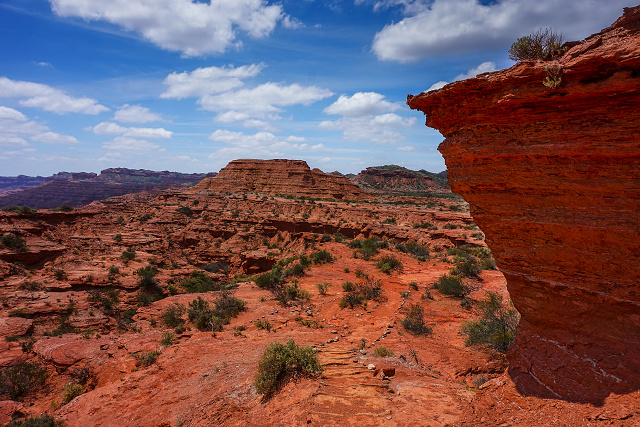
Parque Nacional Sierra de las Quijadas: Rocks
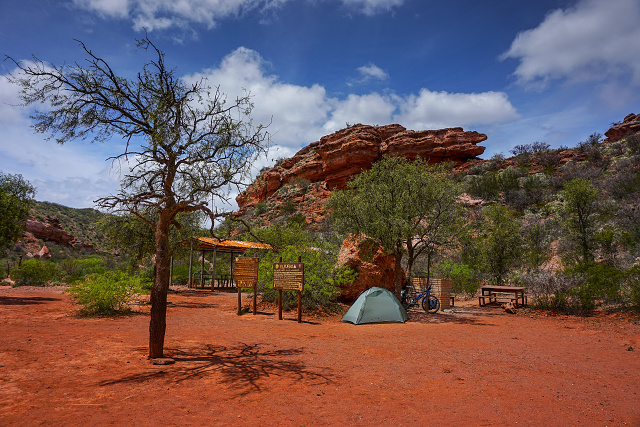
Parque Nacional Sierra de las Quijadas: I spent the night in a very windy camp
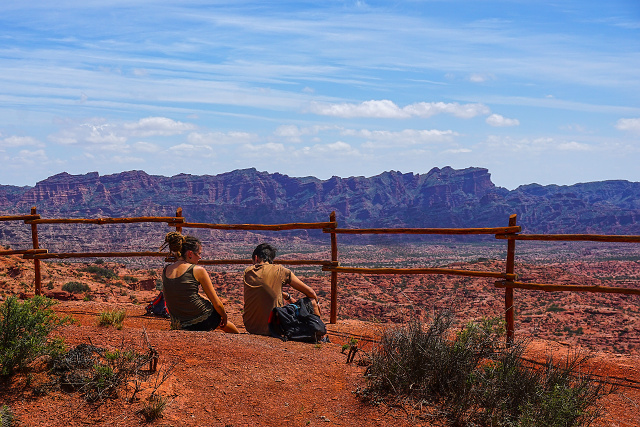
Parque Nacional Sierra de las Quijadas: Karin and Antonio, my pleasant neighbors in the campsite
I enjoyed the Park, walking along all the footpaths and enthralled by the amazing views. One could only enter the canyons with a guide, as it was dangerous and one could easily get lost. The guide was only available during the high season. Nevertheless, I was satisfied and treated it as a day of rest. Surprisingly, I was not the only one in the campsite. There was also a young German woman, Karin, together with an Italian, Antonio. They lived together in Munich and had recently begun their hitchhiking trip around South America. We had a good chat and I gave them some tips on places to visit.
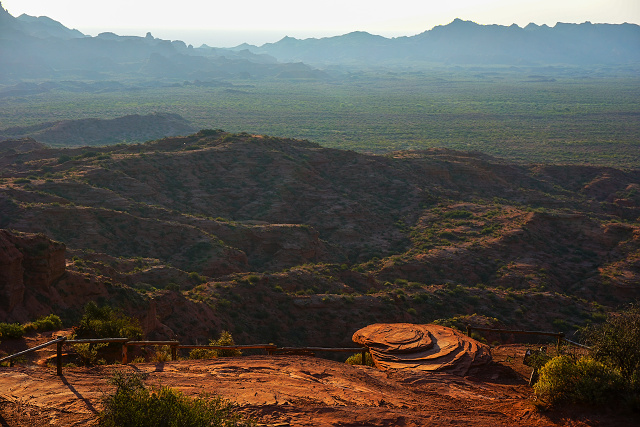
Parque Nacional Sierra de las Quijadas: View from the South terrace before sunset
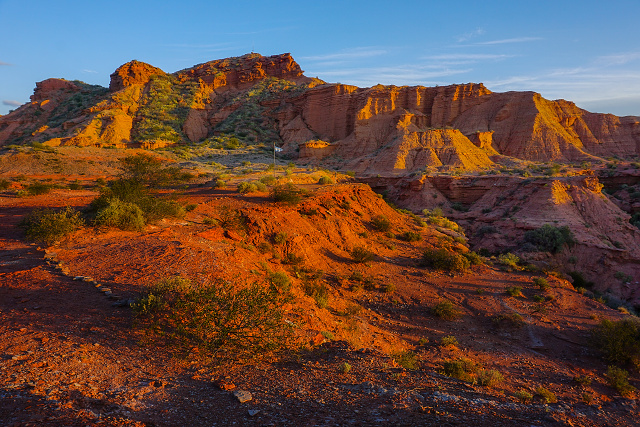
Parque Nacional Sierra de las Quijadas: Evening light colored the rocks even redder
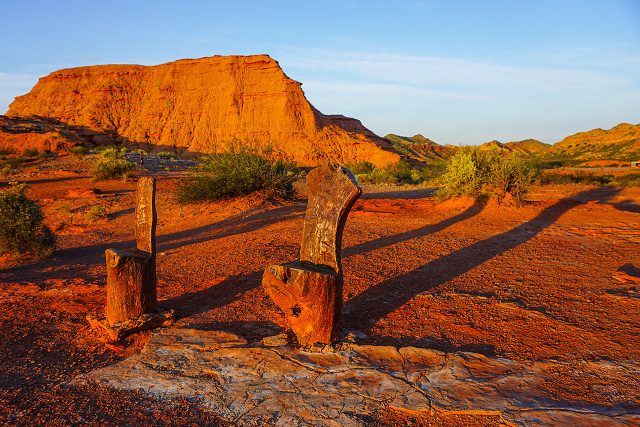
Parque Nacional Sierra de las Quijadas: Seats from which I watched the sunset
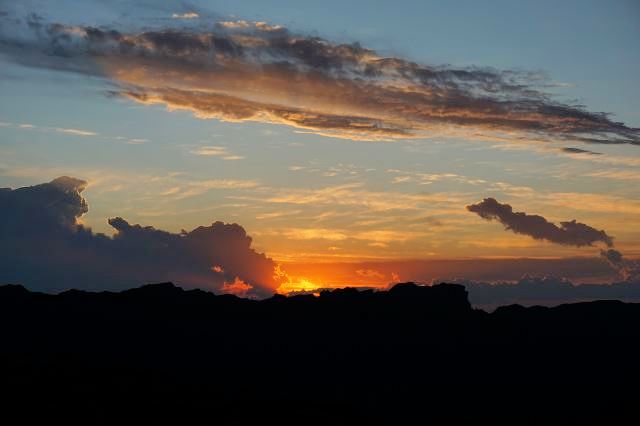
Parque Nacional Sierra de las Quijadas: I could not miss the sunset over the ridge
I left the camp in the morning without saying goodbye to Antonio and Karin, who were still asleep at 08:00. I went back 10 km to La Chanarienta on Road 147. I already knew that I would not find any food there. In the morning, I ate sardines and the rest of the cheese spread with biscuits, which were to take me the 100 km to Encón.
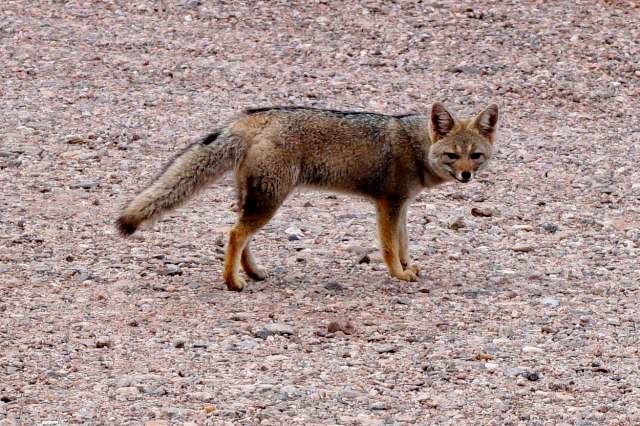
Parque Nacional Sierra de las Quijadas: Zorro gris
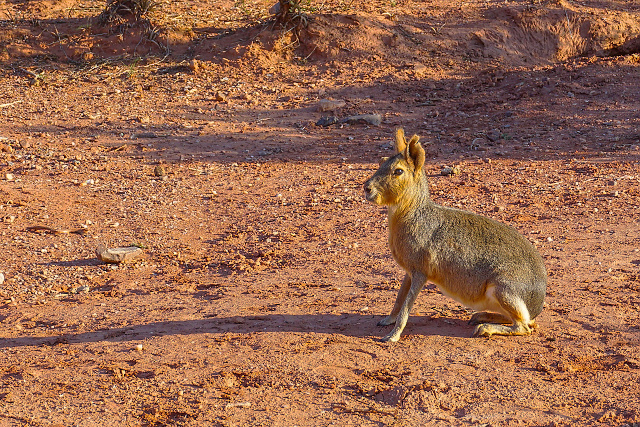
Parque Nacional Sierra de las Quijadas: Local 'overgrown' hares are not afraid of people
I continued on Road 20, which was busier in that part as it connected two big cities: San Juan and San Luis. However, the traffic was not as dense, I did not need to yield on to the grassy verge too often. In La Tranca, I entered San Juan province and the road dramatically deteriorated. Ruts in the road from trucks, cracked asphalt and a fairly damaged road surface on the sides.
I wanted to find accommodation in Encón, finally take a shower and, most importantly, connect to the Internet and congratulate my wife on her birthday for the next day, as well as book accommodation in Mendoza. About 20 km before Encón, I checked the map on the GPS and realized that Encón consists of all of three streets. There certainly would not be any accommodation there. Perhaps at least some food.
That did not turn out too easy either, as no traditional kiosco selling basic food was open. I at least purchased some sandwiches for dinner at the gas station and asked where I could buy some beer. They sent me about 1 km back out of the village. There I found a dilapidated house with the sign: bebidas frescas. The lady sold beer in one-liter bottles, boxed wine and Coca-Cola. I chose the beer. She brought in a chilled bottle and ask me to drink beer on the spot and return the bottle to her. Having one liter of beer in my system when cycling would make me a danger both to myself and the traffic around me. We negotiated in a very complicated way. I wanted to pay 15 pesos extra for the bottle (a standard deposit for a bottle there). The most complicated turned out to be the price calculation: beer for 27, bottle for 15 and the woman was not able to add it up. This advanced mathematical task was entrusted to the two oldest of her four children. Even her approximately12-year-old boy could not work it out. I added it up for her and gave her money. She asked for a piece of paper to be brought to her and counted: 27 for beer (but wrote down 21) and 15 for the bottle (that she wrote down correctly). Then, accompanied by expressive mimicry, she added the figures, surprisingly correctly. For such an effort, I gave her 40 pesos and did not accept any change. She was obviously relieved that the whole process was finished. I wondered how she could have made a living in sales.
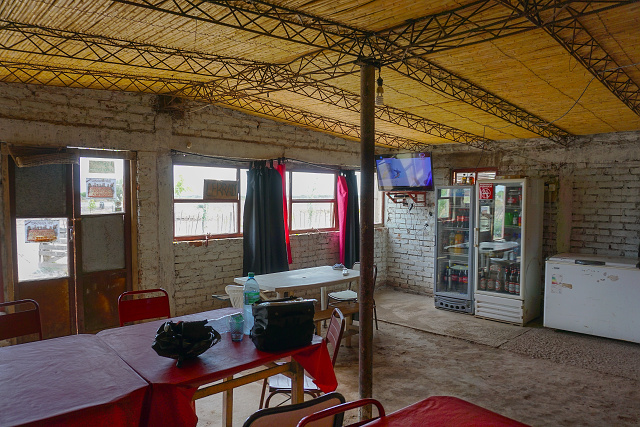
Encón: Parador - dining room - at the intersection of Roads 20 and 142
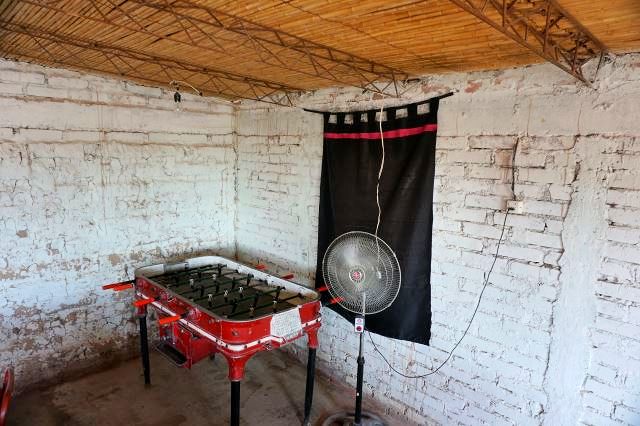
Encón: Parador - dining room - at the intersection of Roads 20 and 142 - the games corner
At the intersection of Roads 20 and 142 beyond the village, there was a stall with a promising sign: parador (food hall). Inside was a young girl breastfeeding her one-month-old, extremely hairy, son. While doing this, she managed to fry a milanesa with two eggs and to prepare a salad with it. I purchased 3 liters of bottled water and everything was A1. Well stuffed, quality water for the following day and, in addition, one liter of beer in my bag, that was the real gem. I relaxed on the bicycle and carefully – so as not to exert my organism in the digestion of a heavy meal, continued southwards.
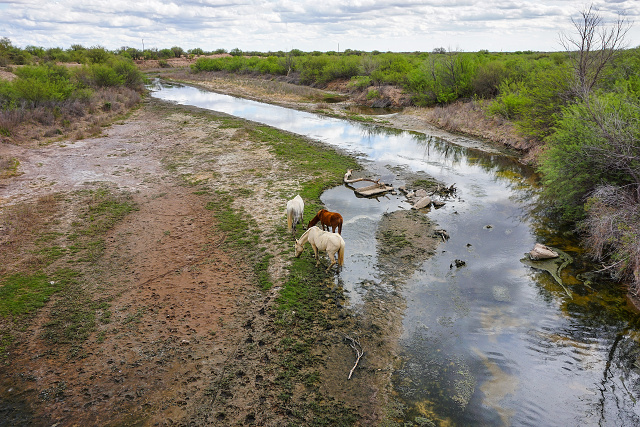
Road 142 near Encón: Surprisingly, there was water in Río San Juan
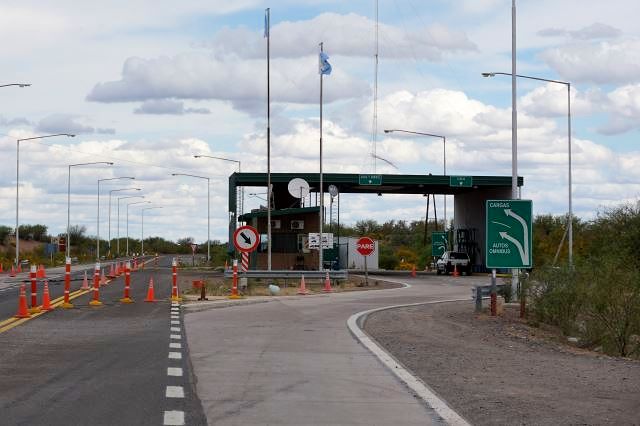
Road 142 near Encón: Tollgate - not a soul passes by unnoticed
35 km later, I found a nifty sleeping spot. There was enough space around the trees and bushes beside the road. The problem was that the semi-desert landscape consisted of rather sandy, loose earth. Pitching a tent on it would mean to have sand just everywhere. Finally, I found a hard, dry spot and hoped that it would not rain during the night, or I would be paddling in the mud all the way up to my ankles. I enjoyed my beer while watching the starry sky. Due to the lack of light pollution, the sky was pitch black and the stars were shimmering like thoroughly polished gold. No chance of seeing that back home.
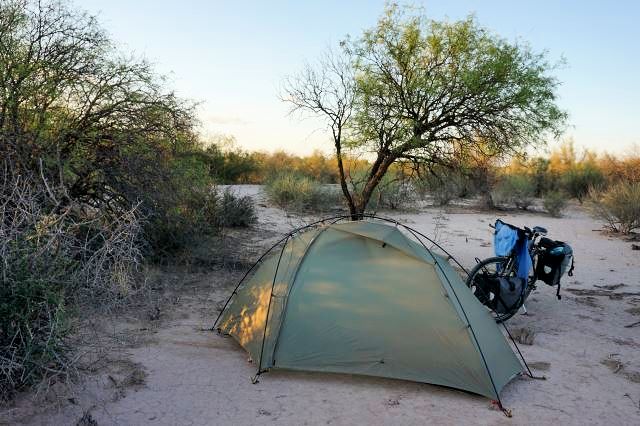
Road 142: Overnight tent site
In the morning, I continued cycling through the Telteca National Reserve, consisting of sand dunes, with a sparse covering of dwarf bushes. I encountered a ranger cycling to work and we spent a pleasant half hour chatting in the road. They certainly did not have clock-in cards at their work. Being on time was certainly not considered a virtue, as it would be in Europe.
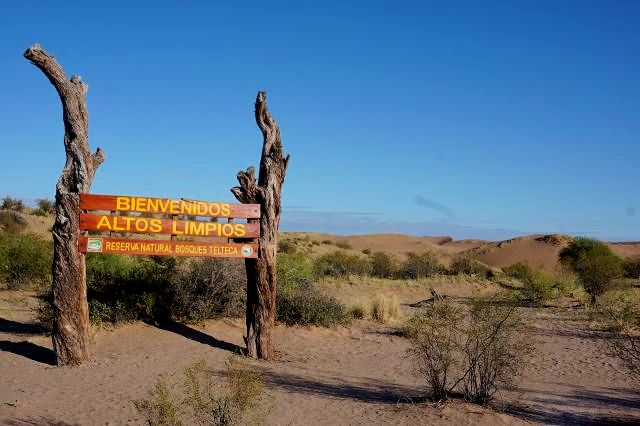
Pto. Los Yauyines: Entrance to Telteca Nature Reserve
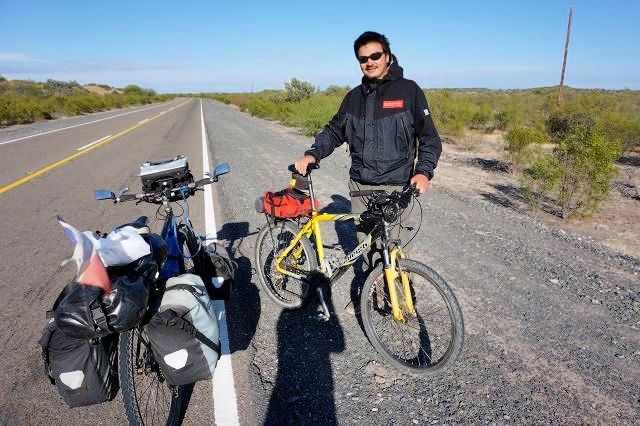
Pto. Los Yauyines: Ranger from Telteca Reserve on his way to work by bike, naturally stopping me for a long chat
People were very friendly. They immediately reacted when seeing my flag with: De donde viene? (Where are you from?). República Checa usually did not mean anything to them. Sometimes they recognized "Czechoslovakia", I usually added Europé Central, just in case. It happened to me twice, though, that someone approached me and said: "That is the Czech flag!" I was impressed by them. Can you recognize, for example, the Danish, Finnish, Belgian, Dutch or Norwegian flags, despite them being our relatively close neighbors?
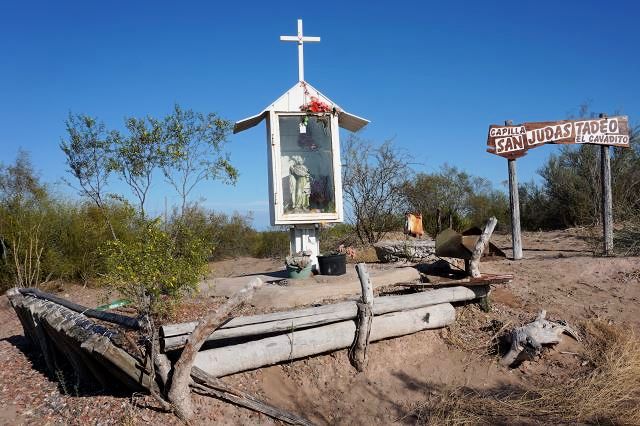
Near El Alpero: Finally, a chapel with a Christian saint (Saint Jude Thaddeus); otherwise there are always Gauchito Gills
The local people had a tendency to relieve my suffering (in their view) in one way or another. For example, the day before I was touched by a truck driver who slowed down and stopped such a colossus in the side lane, only to serve me some Mate from a thermos flask. The truck drivers were my biggest fans. They almost all waved at me, honking their horns or flashing their lights. My awareness of the traffic and moving off the road on to the bumpy verge, so that they would not need to brake when another truck approached from the opposite direction, was always appreciated and thanked by a honking of the horn or flashing lights.
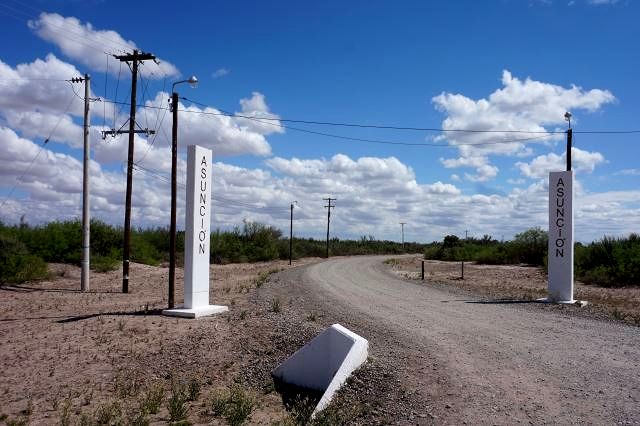
La Asunción: After two months in Asunción again, but not in Paraguay
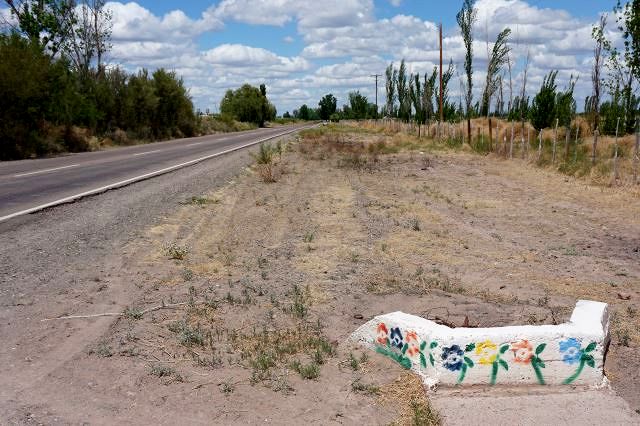
Gustavo André: Local folklore includes painted casts of bridges in ditches beside the road
All long-distance cyclists confirmed the empathy expressed by manual laborers and farmers working along the road. They instinctively feel that we are in the same boat, making a living with our hands and feet. I always waved at them and called: Hola amigos and they usually answered in a similar way. In general, anyone beside the road felt the need to wave and acknowledge my presence. Very pleasant.
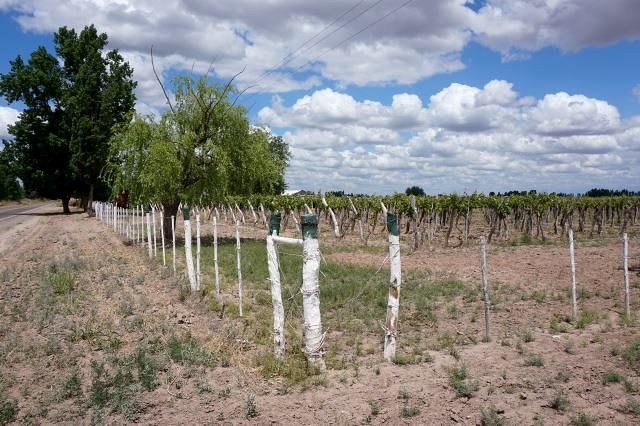
Gustavo André: I come across the first vineyard
It was not even 15:00, I’d had a hard ride against the wind with less than 80 km behind me. I still had 40 km left to Mendoza. The horizon was black, rain was coming. I thought that 40 km was nothing and that I would already be spending that night in Mendoza. I sat down at a bus stop, took out a list of hostels I had got hold of in Montevideo and started calling them one by one. It was bad timing, it was always difficult to find accommodation at weekends. I communicated vigorously in my broken Spanish and, surprisingly, they understood me even over the phone, despite not accompanying my poor linguistic skills with illustrative hand gestures.
They had no single rooms at the hostels. Except at one, where they wanted an unreasonable 420 pesos for a single room without a bathroom. I booked it, just in case, and started calling the already verified hotels, which I had stored in my 4-year-old guide in the Kindle. No answer to the first three numbers. Then I reached Zamora Hotel – in the center, with breakfast buffet, WiFi, en suite room for 280 pesos.
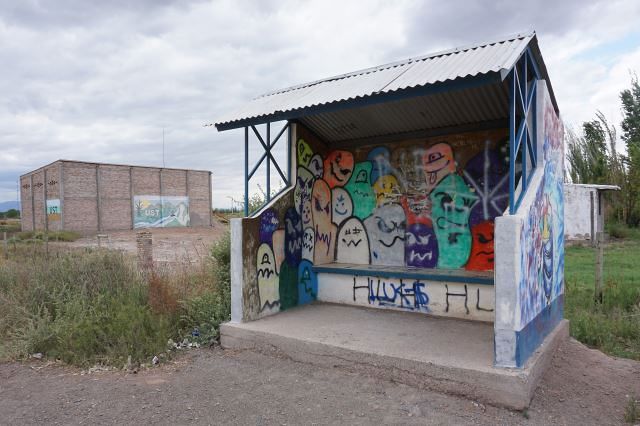
Lavalle: Parada (station) where I spent most of my phone credit to arrange accommodation in Mendoza
I was fixed up. I canceled the reservation I’d made at the hostel, entered the address of the hotel in the GPS and surprisingly located it. I arrived in Las Heras on the outskirts of Mendoza via busy Road 40. The navigator took me through a poor-looking area. Some young boys on bikes stopped me to warn me to return to the main road and to cycle around that area. They thought that it was not safe for me there. I listened to them. Before reaching the main road again, I noticed an autolavado, where a group of young boys were washing cars. On impulse, I asked them how much it would cost to wash my really dirty bicycle. They handed me the hosepipe and turned on the water at my signal. Five minutes later, the job was completed. I wanted to pay them, but they said with a smile: "Free for you, amigo!". I was puzzled about what I was actually supposed to fear in that area.
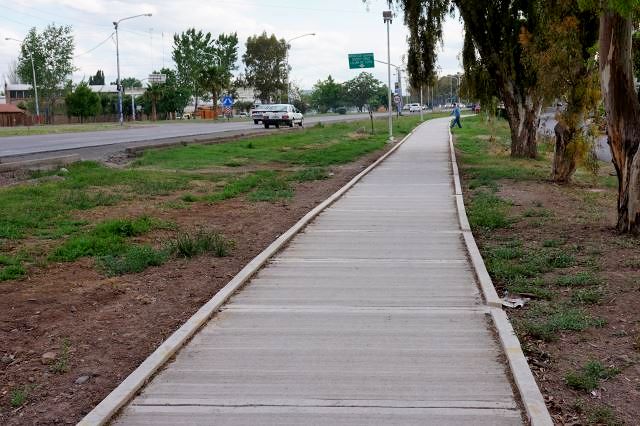
Mendoza: Gleaming new cycle path
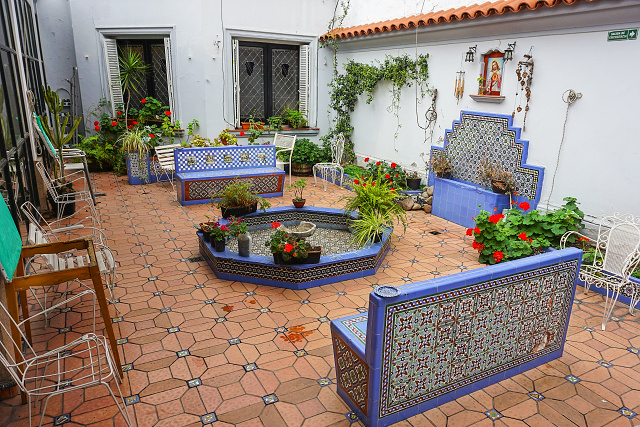
Mendoza: Patio of Hotel Zamora where I stayed
Mendoza
The city has no significant sights and is not really attractive either. The advantage is its location, about 100 km from the Andes and also in the wine center of the region. There are many travel agencies in the city center offering wine tasting and trips to the mountains. One can even find several outdoor equipment stores. Compared to prices back home, everything was too expensive. For example, small gas canister for my stove was CZK 300. I had bought the same thing in Buenos Aires for half that price. I complained about it when shopping and the salesman told me that Mendoza is an expensive region, but he gave me a discount of 20 pesos on the 120-peso price tag. Great, that would be 2 half-liter cans of beer.
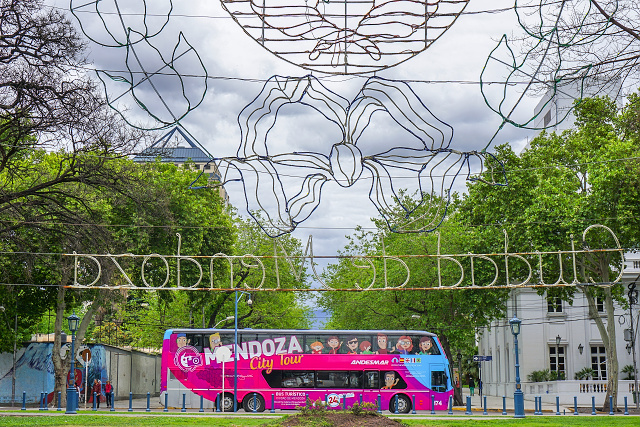
Mendoza: Plaza Independencia – tourist sightseeing bus
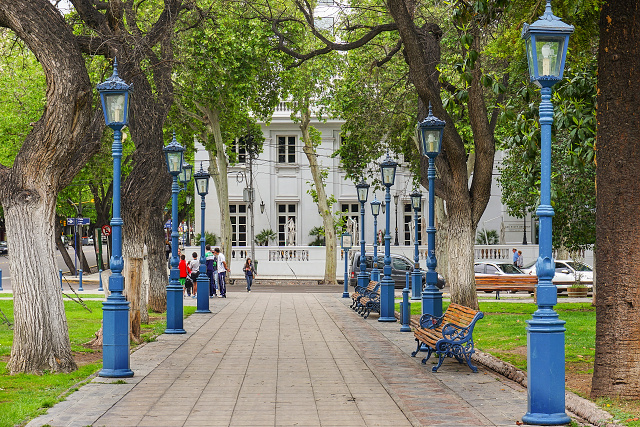
Mendoza: Plaza Independencia
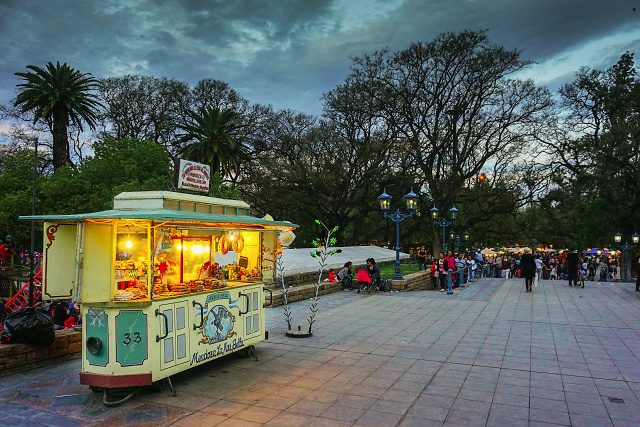
Mendoza: Sweet stall on Plaza Independencia
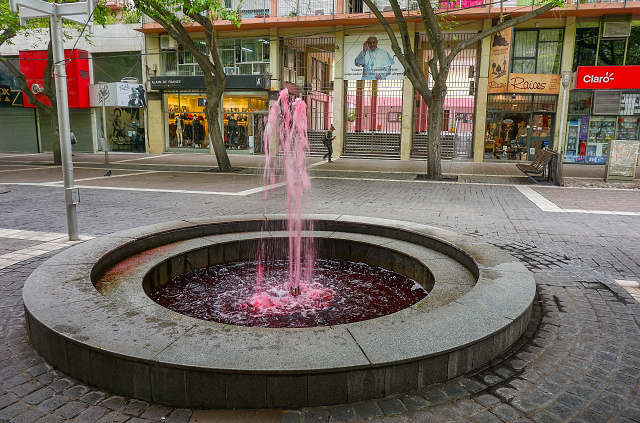
Mendoza: Fountain with rose water in Sarmiento pedestrian zone
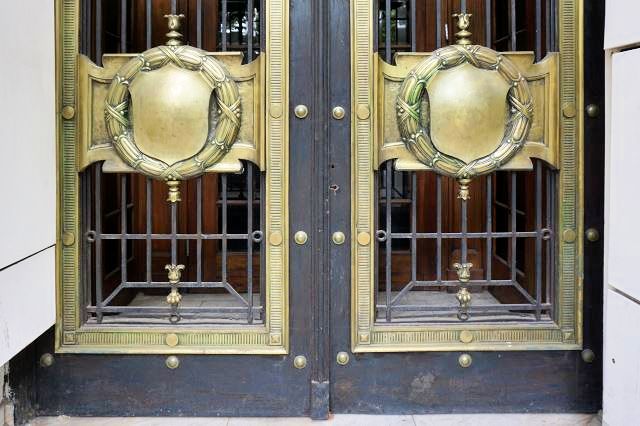
Mendoza: Door of a city building
A curiosity are the deep drainage canals, which are found along almost all the streets in the center. They are necessary. After my arrival, the clouds ruptured and the canals easily coped with the running water. Plaza Independencia is the city center, five minutes from my hotel. The center is formed by a regular network of streets and, three blocks from Plaza Independencia, four small parks are located, each the size of a block.
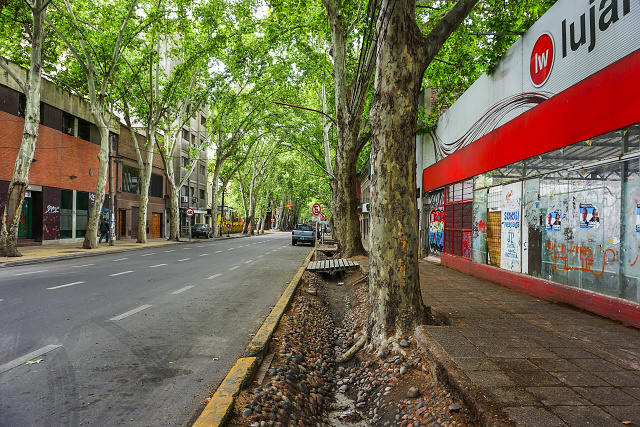
Mendoza: Typical deep drainage ditches

Mendoza: Department store
The advantage of my hotel was also the big Carrefour supermarket, located only two blocks away. I purchased some wine and, learning from the past, double-checked the PLU on the bottle with the PLU on the price tag on the shelf. The wine cost 27 pesos, the price of usually reasonable wines. Together with one beer at 10 pesos, I was charged 47 pesos instead of 37. I argued that they had the wrong price entered in the till. The supervisor went to check and, when he returned, said that I was correct. However, he could not change the price at the till. His solution was elegant: he charged me for 3 beers and not for the wine – a total of 30 pesos. So I even saved money on that.
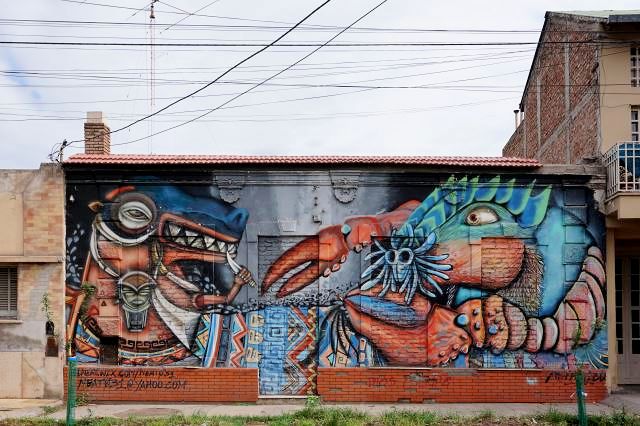
Mendoza: Surroundings beautified by a mural
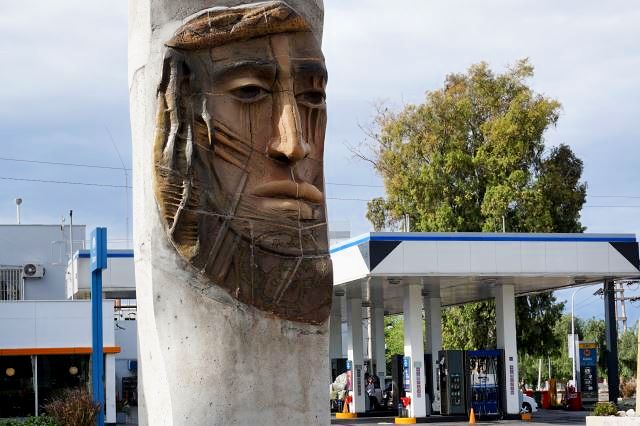
Mendoza: Statue in Area Fundacional - former city center
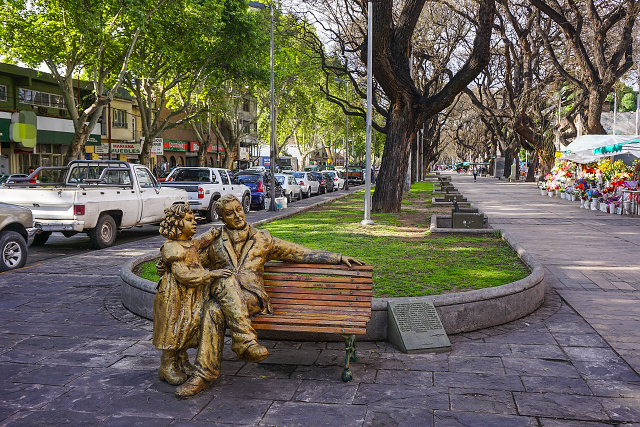
Mendoza: Almeda pedestrian zone
Apart from the center, I also walked around its periphery to reach a park on the site of the original city center, which had been destroyed by an earthquake. On the Sunday, I walked down the popular Aristides Villanueva, an avenue lined with bars, pubs, hotels and hostels. That led me to the extensive San Martin Park, where the locals were enjoying the pleasant Sunday weather. Most of them were lying on the grass, eating picnic food and drinking wine. Seeing that, I felt hungry and went to Plaza Independencia to order a real piece of meat from an outdoor grill, and a glass of red wine.
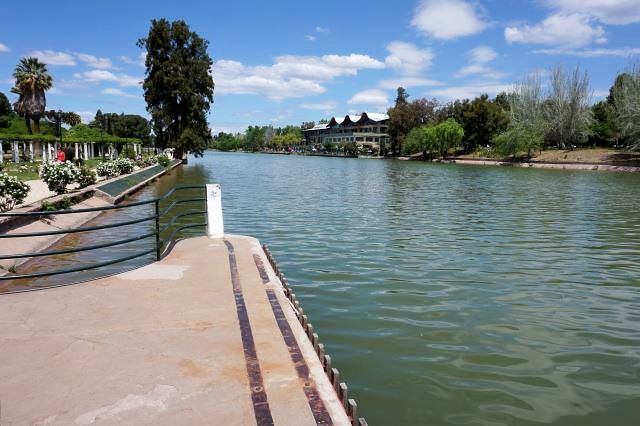
Mendoza: San Martin Park - water reservoir
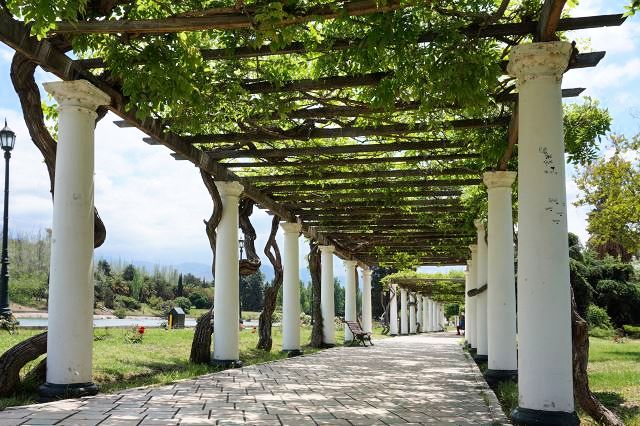
Mendoza: San Martin Park - covered pergola
My instinct, which had chased me into the city as soon as possible, did not fail me. An art festival was taking place on the main square. It was held from the Friday to the Sunday, so I had arrived just in time. Apart from a series of stalls and the aforementioned outdoor grill, music and dance shows were held every afternoon, lasting into the night. The Friday was dedicated to Rock, Saturday to ethnic music and Tango and Sunday to folklore.
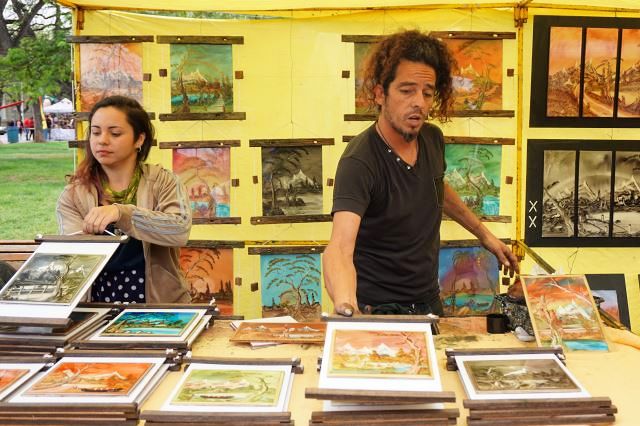
Mendoza: Pictures drawn with fingers
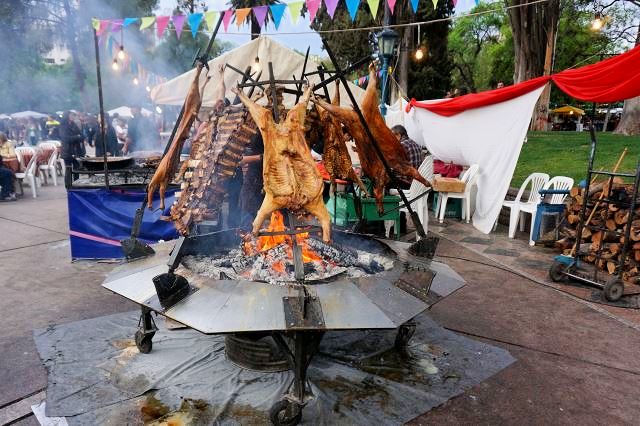
Mendoza: Outdoor parrilla on Plaza Independencia
The genuine Tango has an erotic touch, that is obvious. But there, for the very first time, I saw Tango spiced with humor. A man of about 60 was dancing with a partner half his age. He expressed attraction to the young woman, but also a lack of strength. At times, he went up to the spectators, approached a fatter looking lady of his own age and danced in front of her where she was seated. The young dancer attracted him back to herself and he danced with her, acting as if he was groaning and limping. Finally, he regained his strength and the young lady was his.
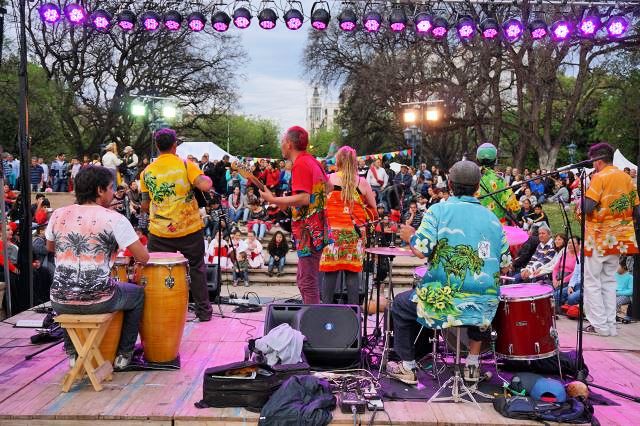
Mendoza: Music stage
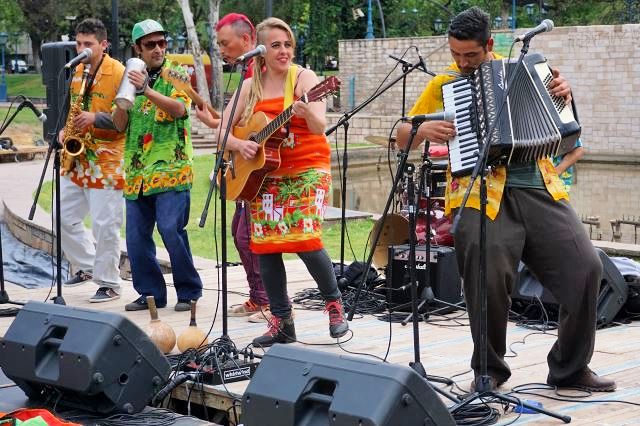
Mendoza: Musical performance by ethnic band
Surprisingly, I also enjoyed the folklore. Some dancers were really overweight dames, but they were so skilled that the audience easily forgot that they had 130-cm waists and were 30 kg overweight. The dancers reveled in their dance and felt like princesses again.
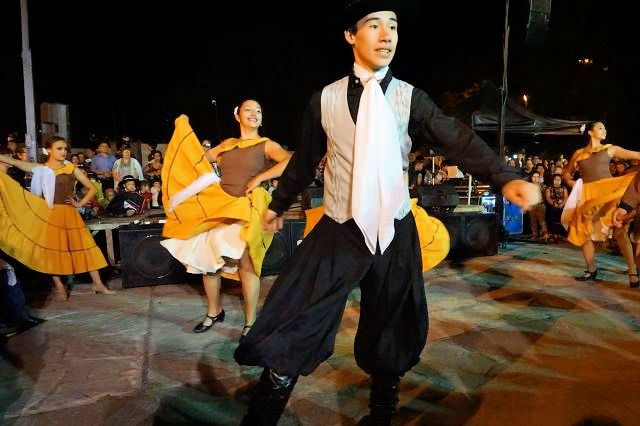
Mendoza: Folklore performances
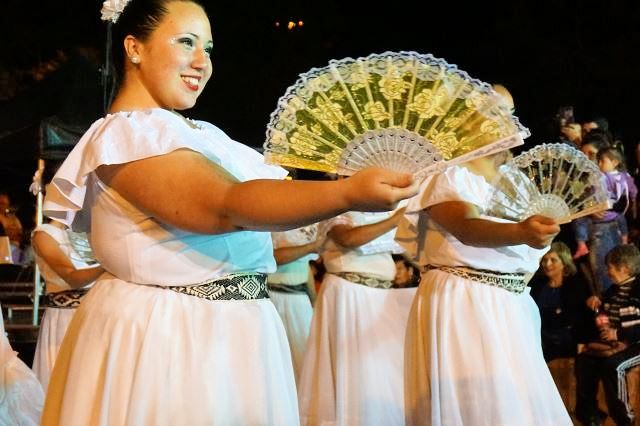
Mendoza: Folklore performance - chubby women danced gracefully too
On the Monday, I could finally get my clothes washed. My long pants were really filthy and it was necessary to wash them. So I wore my cycling shorts with leg warmers for the whole day I looked slightly exotic, but nobody turned around to stare at me.
Wine Tasting
I purchased quite a cheap afternoon excursion to Maipú, which included a visit to two vineyards and an olive oil pressing store. There were 14 of us in a microbus, of whom five were English-speaking – a couple from Australia, two boys from USA and myself. Our guide spoke only Spanish, but English guides were always organized at the main venues.
Bodega López – the first vineyard – was a regular wine-producing factory. It reminded me of Kozel brewery in Velké Popovice. Everything was produced in modern equipment of chrome steel. Only some wines were still matured in huge French Oak barrels, which were 100 years old. Part of the original equipment had been relocated to a museum. The exhibition was fine, the tasting not so. They provided us with a shot-like quantity of red wine and then an equal quantity of terribly sweet white wine, allegedly their pride. The taste reminded me of Tokaj, but they had no idea of its existence. I had a terrible taste in my mouth after the white wine and asked for some extra red wine to correct my taste. They were amazed that I had not appreciated the white one.
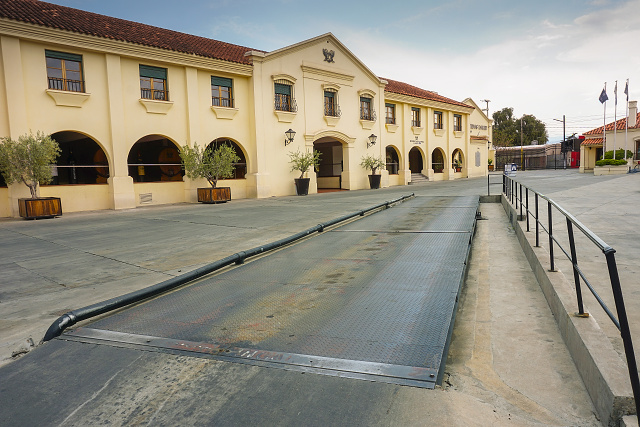
Bodega Lopez: Winery exit leads across the weighing platform
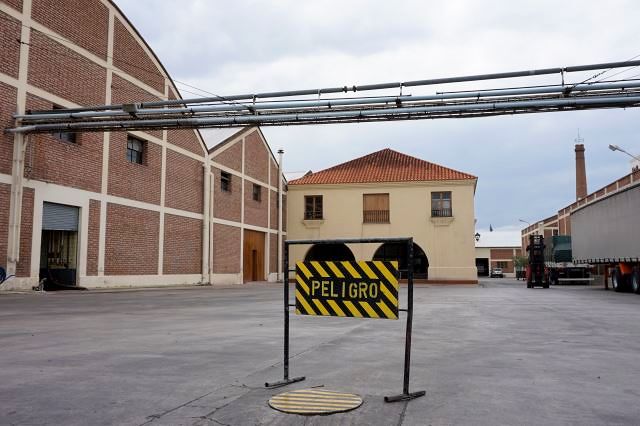
Bodega Lopez: Modern winemaking strongly resembles a factory
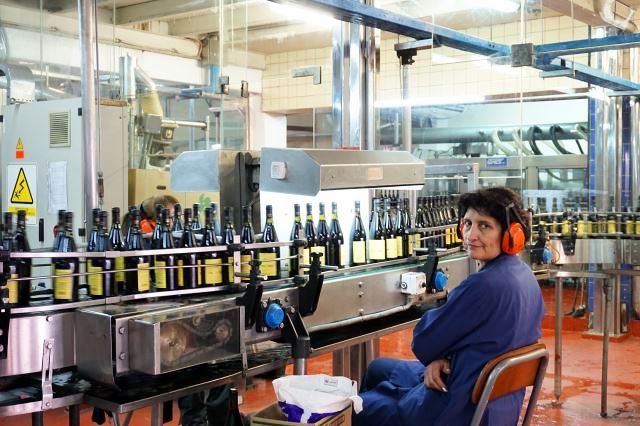
Bodega Lopez: Output control momentarily stopped checking bottles for shipping
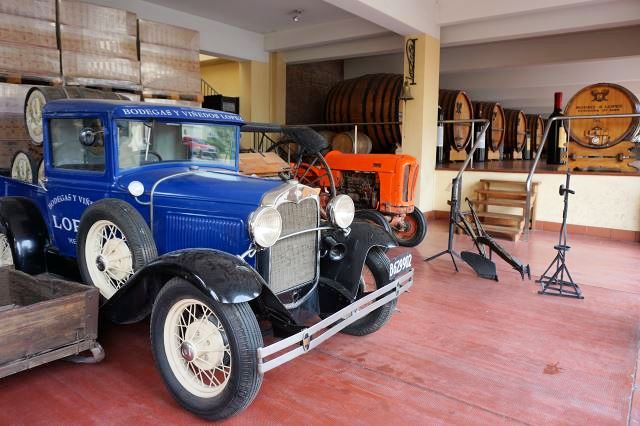
Bodega Lopez: Museum
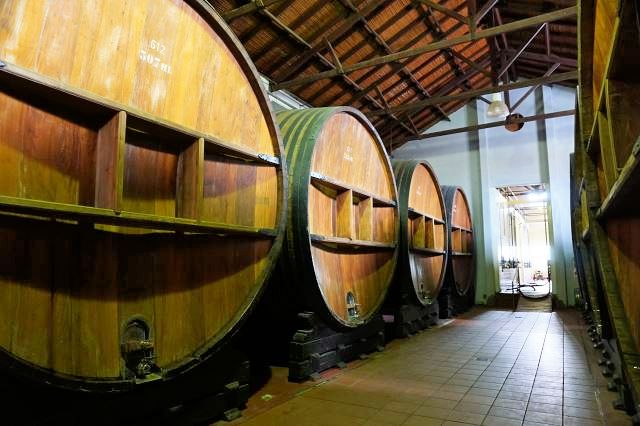
Bodega Lopez: Hundred-year-old French oak barrels
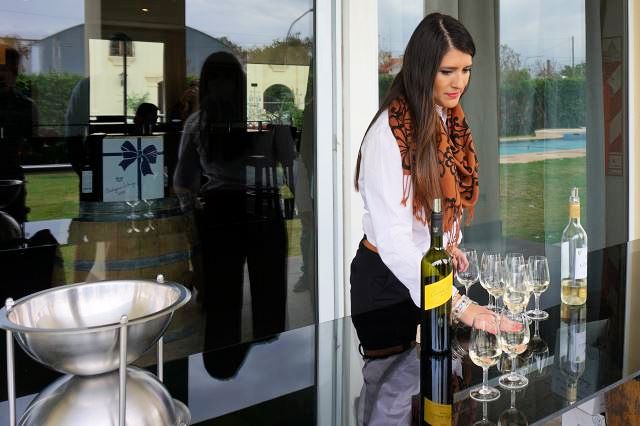
Bodega Lopez: Local guide let us taste one red and one terribly sweet white wine, of which she was proud
Then we visited the Laur olive oil pressing company. Some olives were grown by them and the rest was purchased from other farms. They guided us in detail through an old factory in a gracious Italian-style building. The old equipment was no longer in use, and there was nothing very interesting about the shiny chrome pipes and barrels in the new unit. They made two types of oil and, by mixing it in various ratios, extended their product range to five types. In addition, they also produced a balsamic vinegar.
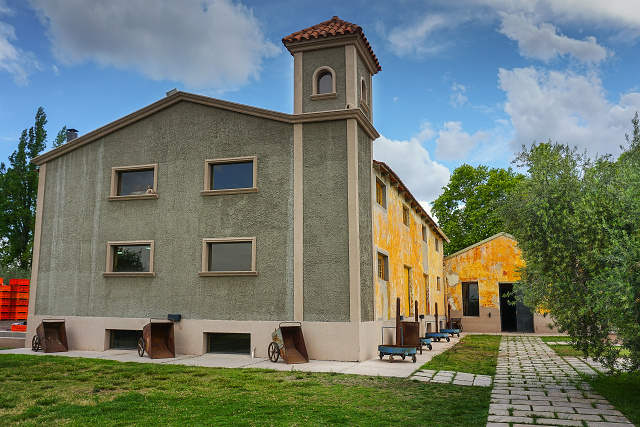
Olive oil factory Laur: Original Italian-style building
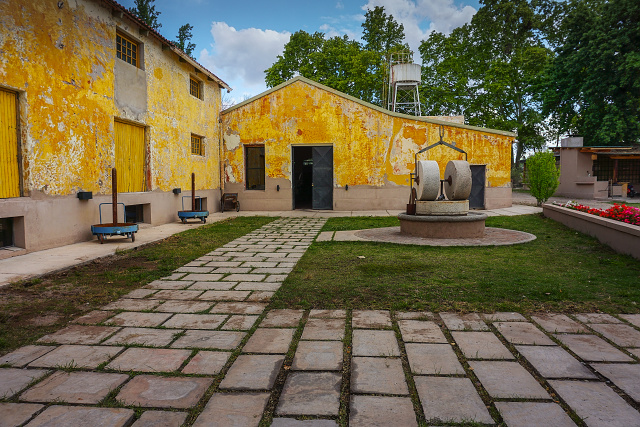
Olive oil factory Laur: Courtyard with stone mill for grinding olives
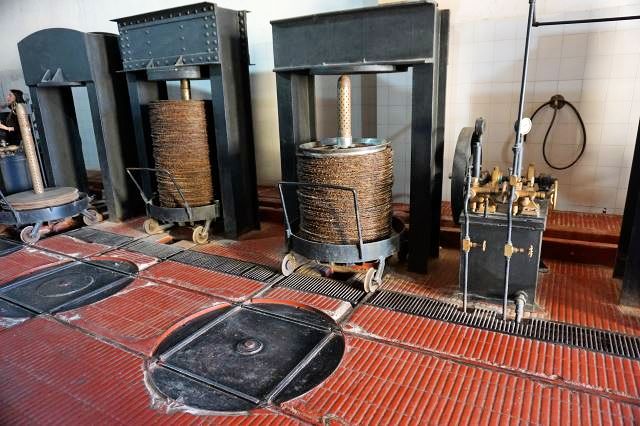
Olive oil factory Laur: Old equipment no longer in use for pressing pre-crushed olives
The last stop was at a small family vineyard which was trying to specialize in more expensive wines. They let us taste three fresh wines from their ordinary production. Then the owner came and personally poured us a thimbleful of their best wine. They were selling it there for 500 pesos per bottle, but the wine was also sold for $ 200 USD in ordinary stores. He sold two bottles – one to Australians and one to an American. They were happy to purchase a valuable present so cheaply.
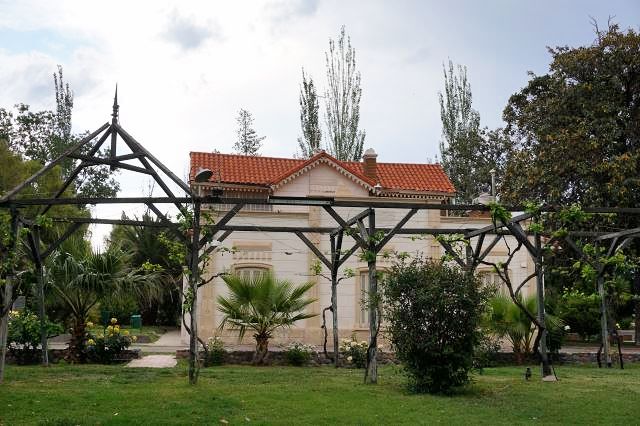
Small winery: House previously lived in by owners, now a store and tourist facilities
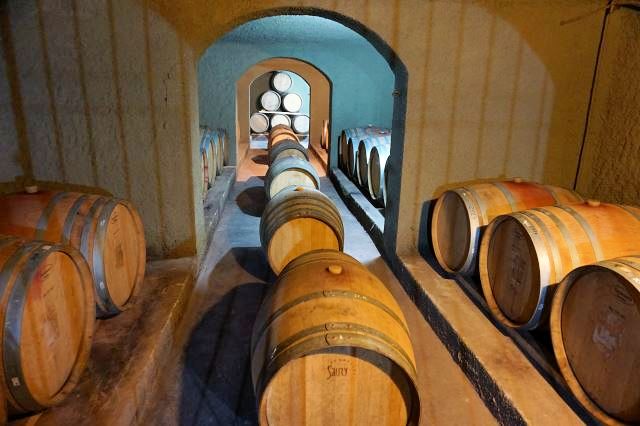
Small winery: The best grapes ripen here
The tour was quite good, except that there was far too little wine. I remembered a similar tour I had been on to vineyards in South Africa. There I had to use all my powers not to get intoxicated by the quantity of wine offered before midday. There was no such risk here.
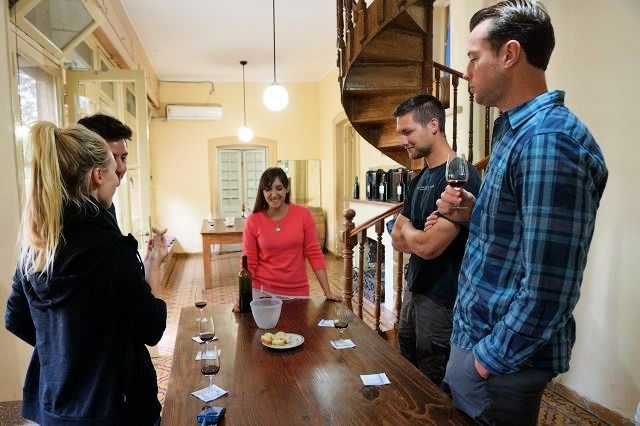
Small winery: English-speaking part of the tour tasting Malbec
